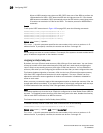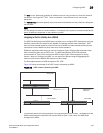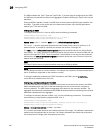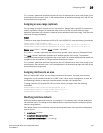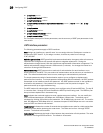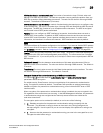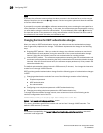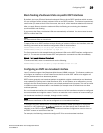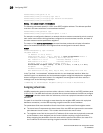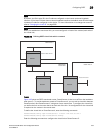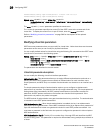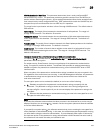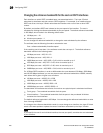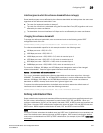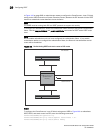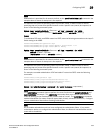
942 PowerConnect B-Series FCX Configuration Guide
53-1002266-01
Configuring OSPF
29
PowerConnect(config)#int ve 20
PowerConnect(config-vif-20)#ip ospf area 0
PowerConnect(config-vif-20)#ip ospf network non-broadcast
PowerConnect(config-vif-20)#exit
Syntax: [no] ip ospf network non-broadcast
The following commands specify 1.1.20.1 as an OSPF neighbor address. The address specified
must be in the same subnet as a non-broadcast interface.
PowerConnect(config)#router ospf
PowerConnect(config-ospf-router)#neighbor 1.1.20.1
For example, to configure the feature in a network with three routers connected by a hub or switch,
each router must have the linking interface configured as a non-broadcast interface, and both of
the other routers must be specified as neighbors.
The output of the show ip ospf interface command has been enhanced to display information
about non-broadcast interfaces and neighbors that are configured in the same subnet.
Example
PowerConnect#show ip ospf interface
v20,OSPF enabled
IP Address 1.1.20.4, Area 0
OSPF state BD, Pri 1, Cost 1, Options 2, Type non-broadcast Events 6
Timers(sec): Transit 1, Retrans 5, Hello 10, Dead 40
DR: Router ID 1.1.13.1 Interface Address 1.1.20.5
BDR: Router ID 2.2.2.1 Interface Address 1.1.20.4
Neighbor Count = 1, Adjacent Neighbor Count= 2
Non-broadcast neighbor config: 1.1.20.1, 1.1.20.2, 1.1.20.3, 1.1.20.5,
Neighbor: 1.1.20.5
Authentication-Key:None
MD5 Authentication: Key None, Key-Id None, Auth-change-wait-time 300
In the Type field, “non-broadcast” indicates that this is a non-broadcast interface. When the
interface type is non-broadcast, the Non-broadcast neighbor config field displays the neighbors
that are configured in the same subnet. If no neighbors are configured in the same subnet, a
message such as the following is displayed.
***Warning! no non-broadcast neighbor config in 1.1.100.1 255.255.255.0
Assigning virtual links
All ABRs (area border routers) must have either a direct or indirect link to the OSPF backbone area
(0.0.0.0 or 0). If an ABR does not have a physical link to the area backbone, the ABR can configure
a virtual link to another router within the same area, which has a physical connection to the area
backbone.
The path for a virtual link is through an area shared by the neighbor ABR (router with a physical
backbone connection), and the ABR requiring a logical connection to the backbone.
Two parameters fields must be defined for all virtual links—transit area ID and neighbor router:
• The transit area ID represents the shared area of the two ABRs and serves as the connection
point between the two routers. This number should match the area ID value.
• The neighbor router field is the router ID (IP address) of the router that is physically connected
to the backbone, when assigned from the router interface requiring a logical connection.
When assigning the parameters from the router with the physical connection, the router ID is
the IP address of the router requiring a logical connection to the backbone.



